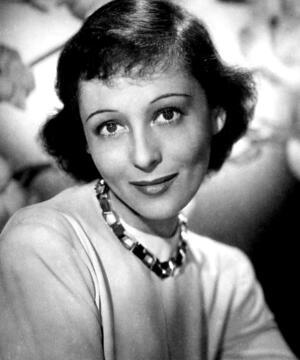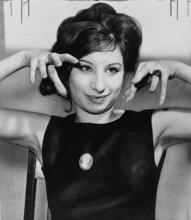Luise Rainer
Publicity photo of Luise Rainer.
Courtesy of Paramount PicturesWikimedia Commons.
Shortly after arriving in Hollywood in 1935 in flight from Nazi persecution, Luise Rainer won unprecedented back-to-back Oscars for her roles in The Great Ziegfeld and The Good Earth. But her Hollywood career quickly evaporated when MGM shoehorned her into roles as an obedient, supportive spouse, out of step with a new social reality; Rainer herself considered Hollywood superficial and devoid of ideas. She became heavily involved in leftist political causes and supporting the war effort, while taking occasional roles on television. In her 80s, she appeared in her first major film release in nearly 55 years, followed by another film in 2003 at the age of 93. Luise Rainer is an inspiring reminder that it’s never too late to return for the “second act.”
Born in Düsseldorf on January 12, 1910, to Heinrich and Emilie Königsberger Rainer, Luise Rainer was not a woman to mince words. Her New York Times 2014 obituary cited how she had judged the two 1930s films for which she received back-to-back Academy Awards as unworthy. In the days when Hollywood studios owned stars, Rainer chafed against being “one of the horses of the Louis B. Mayer stable.” She eventually left Metro-Goldwyn-Mayer (MGM), but not before getting the chance to tell off one of Hollywood’s most powerful men, well ahead of her time in challenging male hierarchy. “Mr. Mayer, you did not make me,” Rainer recalled of her defiance to the executive during her 2010 interview. “You are an old man… By the time I am 40 you will be dead.” Rainer turned 47 before Mayer died. By the time she died at 104 in her home in London, she had outlived him by almost an additional sixty years.
Ambivalence about Jewishness
According to a 1983 interview with Rainer, her father came to Texas as a six-year-old orphan before returning to Europe as a businessman. Her mother was a concert pianist. Rainer grew up with two brothers. She later recalled that by the time she was 17, her parents had thrown her out of the house when she declared her intention to pursue a career in acting.
Like many highly assimilated middle-class Jews in Germany, Rainer did not particularly identify with being Jewish, a point that soon would become irrelevant under Nazi anti-Semitism. Rainer reflected in 2004 that she was completely “unaware of my Jewishness until I was 23 years old.” Indeed, after her first marriage to playwright Clifford Odets ended in 1940, she converted to Christianity and was christened after marrying New York publisher Robert Knittel (d. 1989) in 1945. “I do not believe in any religion as it only creates strife!” she wrote upon learning of her inclusion in an encyclopedia of Jewish women. “See the world today!!!”
Such were the views of someone who had witnessed Germany’s devastating post-World War I economic depression, who “watched the Reichstag burn in 1933,” according to The New York Times, “and heard Hitler on the radio.” They also were the views of someone deeply engaged with global politics, speaking out against the rise of worldwide fascism throughout the 1930s, caring for orphaned refugees of the Spanish Civil War, and assisting Allied efforts to raise war bonds and entertain troops during World War II.
Career Rise & Fall
Joining the company of legendary theater director Max Reinhardt in 1930s Vienna, Rainer achieved acclaim on the European stage and screen in her early twenties. She arrived in Hollywood in 1935 amid a wave of European artists, writers, scientists, and other intellectuals fleeing Nazi persecution. Within a year, she had played her most memorable roles opposite the biggest stars of the day: William Powell in The Great Ziegfeld (MGM, 1936) and Paul Muni in The Good Earth (MGM, 1937). Her performances earned raves and an unprecedented two successive Oscars. As part of the gallery of MGM luminaries, she also helped define the studio’s reputation as the “Tiffany” of motion picture companies in Depression-era America.
In both The Great Ziegfeld and The Good Earth, Rainer played long-suffering, indefatigable, and loyal wives, first to celebrated impresario Florenz Ziegfeld and then to a Chinese peasant. Both performances had far more depth and nuance to them than the studio seemed to recognize. Although MGM’s publicity tried to mold her into the next Garbo, her subsequent roles superficially typecast her as an obedient, supportive spouse, and characters featuring stronger, more independent women eluded her. While a succession of undesirable studio-imposed roles and her disastrous marriage to Odets certainly did not help her career, MGM’s shoehorning of Rainer into a “star text” of the pliant and long-suffering wife soon appeared out of step with a new social reality. As the Roosevelt administration prepared the country to enter World War II, industry and labor were about to usher women into the workforce as temporary replacements for their male counterparts fighting overseas.
Today, one of Rainer’s greatest parts, as O-Lan in The Good Earth, also strains under the weight of condescending ethnic stereotyping. However compelling, the performances of both Muni and Rainer offer the uncomfortable reminder that actual Asians and other minorities were largely invisible, seen only through stereotypes rendered by white actors and actresses in yellow face.
Within three years, Rainer’s Hollywood phase had vaporized almost as quickly as its meteoric success had taken shape. Influential Hollywood gossip columnist Louella Parsons snidely diagnosed Rainer with what she called the “Oscar curse.” For her part, Rainer considered Hollywood superficial and largely devoid of ideas. Eschewing the glamor images of female stars promulgated through studio publicity, she had a reputation for going without makeup and dressing in comfortable old clothes. She reportedly even came to the 1936 Academy Award ceremonies several hours late, and with her hair in disarray.
Political Involvement
Offscreen, Rainer hardly fit the image of the lachrymose heroines she often portrayed. Along with Odets, Rainer joined other Hollywood talents as a part of the Popular Front, a broad-based coalition of leftist political activism emerging out of Los Angeles during the 1930s. She served as one of the founding members (along with Muni, journalist Dorothy Parker, novelist and playwright Lillian Hellman, actress Gale Sondergaard, and other Hollywood notables) of the Motion Picture Artists Committee and the Joint Anti-Fascist Refugee Committee, organizations devoted to the cause of Republican Spain against the totalitarian forces of Generalissimo Francisco Franco.
Later Career
With the collapse of the Popular Front by the late 1930s and her divorce from Odets, Rainer increasingly eluded public view. Her last Hollywood film, Hostages (1943), received a lukewarm reception despite its timely depiction of the World War II underground resistance movement. Rainer then nearly vanished from the Hollywood scene. She made infrequent guest appearances on European and American television throughout the 1950s and 1960s, including an episode for the thriller anthology series Suspense (“Torment,” March 30, 1954) and opposite silent film star Ramon Navarro in the World War II series Combat (“Finest Hour,” December 21, 1965), in which she played a sympathetic countess. In 1984, she guest starred in a dual role for an episode of the ABC series The Love Boat.
In later life, Rainer split her time between London and Switzerland. In 1988, she appeared in “A Dancer,” a short film produced for Italian television. That year People Weekly interviewed her for the sixtieth anniversary of the Oscars. Ten years later, she was a featured guest at the seventieth anniversary Academy Award ceremonies.
In 1997, then octogenarian Rainer appeared in her first major film release in nearly fifty-five years. The Gambler, a Hungarian/English “story within a story” that weaves the Dostoyevsky tale of the same name with a story about his writing of it, premiered in Europe and opened in the United States in 1999. One critic described her performance as “radiant one moment, bereft the next, so feverishly animated that you cannot take your eyes off her.” Appearing in yet another film in 2003 at the age of 93, Luise Rainer – whose one hundred and four years defy easy categorization – was an inspiring reminder that it’s never too late to return for the “second act.” Or that you’re never too young to stick it to one of the most powerful men in Hollywood.
Luise Rainer died on December 30, 2014.
Select Filmography
Poem – Ich setze den Fuss in die Luft, und sie trug (Poem: I Set My Foot Upon the Air and It Carried Me) (2003).
The Gambler (1997).
Hostages (1943).
Dramatic School (1938).
The Great Waltz (1938).
The Toy Wife (1938).
The Big City/Skyscraper Wilderness (1937).
The Emperor’s Candlesticks (1937).
The Good Earth (1937).
The Great Ziegfeld (1936).
Escapade (1935).
Heute kommt’s drauf an (1933).
Madame hat Besuch (1932).
Sehnsucht 202 (1932).
Ja der Himmel über Wien (1930).
Baskette, K. “Know Luise Rainer.” Photoplay 48, no. 5 (1935): 44.
Bronner, E. “Luise Rainer.” Films in Review 6, no. 8 (1955): 390.
Ceplair, Larry, and Steven Englund. The Inquisition in Hollywood: Politics in the Film Community, 1930–1960. Berkeley and Los Angeles: University of California Press, 1983.
Crichton, K. “Girl Who Hates Movies.” Collier’s, May 23, 1936: 36.
Daugherty, F. “Luise Rainer in a New Role.” Christian Science Monitor Magazine, August 24, 1938: 4.
Fletcher, A.W. “The Tempestuous Life Story of Luise Rainer.” Photoplay 50, no. 1 (1936): 24, and 50, no. 2 (1936): 74.
Hall, L. “The Romantic Story of Luise Rainer’s Surprise Marriage.” Photoplay 51, no. 3 (1937): 50.
Hamilton, S. “What’s Happened to Rainer?” Photoplay 52, no. 6 (1938): 22.
“Happy 60th Oscar,” People Weekly (April 11, 1988): 85. Reprinted in Academic Index Database.
Katz, Ephraim. “Luise Rainer.” Katz’s Film Encyclopedia. Reprinted in Microsoft Corp., Cinemania CD-ROM (1996).
Lewis, Kevin. “Luise Rainer: She Did it Her Way.” Movie Maker Magazine 35 (2003).
Littleton, Cynthia. “Luise Rainer; 20 Things You Didn’t Know About the Legendary Actress.” Variety (30 Dec. 2014).
“Luise Rainer.” Hollywood Celebrity Biography (2004).
“Luise Rainer: Celebrating the life and work of Luise Rainer (1910-2014). (Website.)
Luther, Claudia. “Luise Rainer Dies at 104; 1930s Star Had Meteoric Rise and Fall in Hollywood.” The Los Angeles Times (30 Dec. 2014).
Macatee, Rebecca. “Luise Rainer, First to Win Back-to-Back Acting Oscars, Dies at 105.” Eonline.com (30 Dec. 2014).
McFadden, Robert D. “Luise Rainer Dies at 104; Won Best Actress Oscars for Two Years Running.” The New York Times (30 Dec. 2014).
Rainer, Luise. Letter to the author. n.d. [2004].
“Thank Offering; Shaw’s Saint Joan.” Time (March 18, 1940): 68.
Thomas, Bob. “The Viennese Vivacity: Actress Sets Sail on TV after 20-Year Absence.” The Atlanta Constitution (24 Nov. 1983).
“Where Are They Now?” Newsweek (April 15, 1963): 20.




